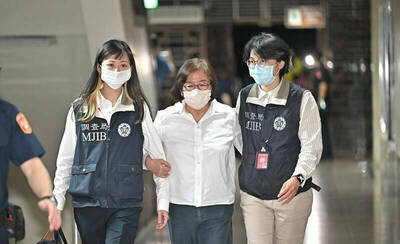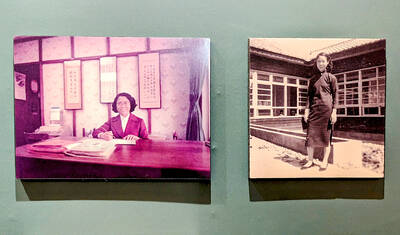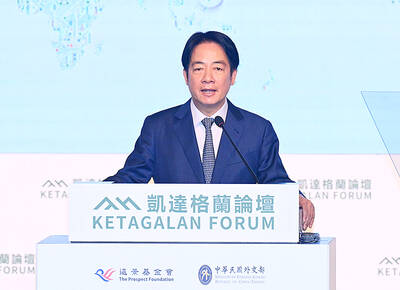Weeds are conquering the gardens, and the last elderly residents of Sanchung's Air Force First Village (空軍三重一村) are moving out. As village chairman Wang Chih-hsin (王繼新) leads a tour of his childhood home, a now-vanished world comes to life in his mind.
He points to the concrete platform built for a Japanese anti-aircraft battery. Villagers gave it a tarp and added stone tables, wood chairs and electrical wiring to make it a central gathering space. He wanders through the empty lanes where children played games and rode bicycles. He cracks open a creaky gate to a lonely house covered by an overgrown banana tree.
"Because I grew up here, there is some kind of bond. I feel for every person and all the buildings and plants, the trees and the flowers," Wang says, choking back tears as he shuts the gate. "It's sad to see the whole thing disappear … for all the people to go away and disperse."

PHOTO: TAIPEI TIMES
Once a defining part of Taiwan's urban landscape, veterans' villages like this one are being abandoned, left to wild dogs and the derelict, awaiting transformation into parks, cultural institutions or commercial real estate. Built for the Chinese Nationalist Party (KMT) troops who fled China with Generalissimo Chiang Kai-shek (蔣介石) in the late 1940s, these were once proud islands of Mainlander culture, separated from the surrounding neighborhoods by walls and gates, dialects and customs. When the last juan cun (眷村), or military dependents' village, is torn down in 2009, a unique subculture will disappear — and a chapter of Taiwan's history will come to a close.
Unlike other symbols of the KMT's migration to Taiwan, veterans' villages have, for the most part, faded away peacefully — generally, the change has not been seen as a triumph of Taiwanese identity over Chinese traditionalism. Originally built from bamboo and straw as temporary barracks for troops preparing to retake China, the compounds were never intended to be permanent. After decades of unplanned-for expansion, they were blocking urban development and becoming dangerous places to live.
In 1982, there were roughly 880 veterans villages housing more than 100,000 families. Four fifths of these were in northern Taiwan, with the rest scattered across the country as far as Penghu and Matsu. Using stronger materials like bricks and tiles, residents had expanded their homes until in many cases only narrow alleys separated units, turning the villages into low-slung warrens of decaying, jerry-rigged architecture.
The government in 1996 passed the Statute Governing Reconstruction of Old Military Dependents' Villages (國軍老舊眷村改建條例), which budgeted money to demolish the villages and replace them with modern, high-rise housing. Though motivated in part by concerns for the residents' welfare, the decision was also political. The KMT under then-president Lee Tung-hui (李登輝) was pursuing a policy of localization, one that alienated many living in the veterans villages, which had been "storehouses of votes" for his party. Subsidizing the construction of new homes was seen as a ploy to prevent the veterans and their families from voting for the New Party, which had broken from the KMT over Lee's Taiwan-first agenda.
Inevitably, the ethnic angle was exploited. Alarmed by the pace of redevelopment — more than 700 villages have already been torn down — preservationists proposed an amendment to the Statute Governing Reconstruction of Old Military Dependents' Villages giving local governments incentives to preserve cultural and architectural aspects of the villages. The amendment enjoyed broad support, until earlier this year when KMT legislators Chu Fong-chi (朱鳳芝) and Lu Shiow-yen (盧秀燕) proposed additional amendments that would compensate veterans who never received housing in the villages. The move gave Democratic Progressive Party (DPP) legislators an opening to attack the preservation effort, calling it another example of government largess for veterans, one that used money that could more fairly be spent on subsidies for fishermen and farmers, groups that are predominately Taiwanese.
On Jan 10, DPP legislators William Lai (賴清德) and Sandy Yen (莊和子) held a press conference urging KMT lawmakers to withdraw the amendments, which they said would cover half a million veterans and cost the government NT$1.49 trillion.
Lai and Yen declined requests for interviews. Chu, who counts veterans and their dependants as a core constituency in her Taoyuan district, said in an interview at her office that her proposals would only cover a few thousand households. Preservationists, who credit Chu with helping sponsor their original amendment, say her add-ons gave DPP legislators room to spin the issue and exaggerate the money involved.
"It was a numbers game," said Chang Mao-kuei (張茂桂), president of the Association of Mainlander Taiwanese (外省臺灣人協會) and a sociologist at Academia Sinica, who helped push the original amendment. "They inflated the numbers to make whoever proposed the amendment look bad," while "the people who proposed [the additional amendments] could not" explain why they were needed or how much they would cost. "To my knowledge, some of those veterans may have already received housing subsidies for not living in juancun."
Mao noted that the original amendment enjoyed bi-partisan support. "Our intention was just to preserve the cultural memory," he said.
Sitting on a bench outside the central meeting area at Air Force First Village, a large Republic of China flag flapping in the breeze beside him, Wang says the spat over the amendments highlights the need for preservation. He acknowledges that villagers originally closed themselves off from the working-class Taiwanese neighborhood growing up around them, and DPP politicians did not dare until recently to enter the compound. But many veterans married Taiwanese women, as did their children and grandchildren. Lately, though residents may still lean pan-blue — cartoon figurines representing Lien Chan (連戰) and James Soong (宋楚瑜) stand on a nearby table — they worked with the local DPP legislator to preserve the village as a government-designated historical site.
"We want to be called Taiwanese, too," he says. "We simply want to preserve a culture that has existed for 60 years, because if we have a better understanding of each other, this will enhance mutual respect between ethnic groups."
Wang's village is ideal for such an effort. Built for Air Force officers, its houses and open spaces are much larger than those in veterans villages built for enlisted men and their families. He hopes to turn some of the houses into a museum, rent out others as bed-and-breakfasts, and use the revenue to fund preservation.
This summer, a Taipei County committee resolved to register his village's buildings as historic sites. A final decision is still pending, awaiting, preservationists say, the Legislature's decision on the amendments to the Statute Governing Reconstruction of Old Military Dependents' Villages.
Elsewhere, villages in Tainan, Taoyuan and Matsu counties have already been designated as historic sites. Hsinchu recently opened a Military Dependents' Village Museum (新竹市眷村數位博物館),
and the Taipei city government has renovated part of Xinyi District's 44 South Village (四 四南村) in Taipei, a row of one-story structures once deemed an eyesore and slated for demolition.
Though Wang and others worry how they will fund maintenance and attract visitors, such efforts seem to be immune from ethnic politicking. The same is not true for the welfare of the old veterans who have moved into the new communities. They may need additional government support in the form of social services, but calls for such support could meet with opposition from pan-green legislators.
"The old residential [communities] were very close-knit," Academia Sinica's Chang explained. "Now the situation has changed. The old folks are moving into these modern apartment complexes, while their children have moved on, often to different cities. The elderly have special needs but have been cut off from their traditional support networks. They are not necessarily poor, but they probably need assistance to be connected with the outside world, whether it's for medical or other reasons."
"Given the political situation today, you cannot ask for additional social services for veterans, even though their wives are Taiwanese and their children are half and half. They are still regarded as Mainlanders," Chang said.

Following the shock complete failure of all the recall votes against Chinese Nationalist Party (KMT) lawmakers on July 26, pan-blue supporters and the Chinese Communist Party (CCP) were giddy with victory. A notable exception was KMT Chairman Eric Chu (朱立倫), who knew better. At a press conference on July 29, he bowed deeply in gratitude to the voters and said the recalls were “not about which party won or lost, but were a great victory for the Taiwanese voters.” The entire recall process was a disaster for both the KMT and the Democratic Progressive Party (DPP). The only bright spot for

Aug. 11 to Aug. 17 Those who never heard of architect Hsiu Tse-lan (修澤蘭) must have seen her work — on the reverse of the NT$100 bill is the Yangmingshan Zhongshan Hall (陽明山中山樓). Then-president Chiang Kai-shek (蔣介石) reportedly hand-picked her for the job and gave her just 13 months to complete it in time for the centennial of Republic of China founder Sun Yat-sen’s birth on Nov. 12, 1966. Another landmark project is Garden City (花園新城) in New Taipei City’s Sindian District (新店) — Taiwan’s first mountainside planned community, which Hsiu initiated in 1968. She was involved in every stage, from selecting

As last month dawned, the Democratic Progressive Party (DPP) was in a good position. The recall campaigns had strong momentum, polling showed many Chinese Nationalist Party (KMT) lawmakers at risk of recall and even the KMT was bracing for losing seats while facing a tsunami of voter fraud investigations. Polling pointed to some of the recalls being a lock for victory. Though in most districts the majority was against recalling their lawmaker, among voters “definitely” planning to vote, there were double-digit margins in favor of recall in at least five districts, with three districts near or above 20 percent in

The great number of islands that make up the Penghu archipelago make it a fascinating place to come back and explore again and again. On your next trip to Penghu, why not get off the beaten path and explore a lesser-traveled outlying island? Jibei Island (吉貝嶼) in Baisha Township (白沙鄉) is a popular destination for its long white sand beach and water activities. However, three other permanently inhabited islands in the township put a unique spin on the traditional Penghu charm, making them great destinations for the curious tourist: Yuanbeiyu (員貝嶼), Niaoyu (鳥嶼) and Dacangyu (大倉嶼). YUANBEIYU Citou Wharf (岐頭碼頭) connects the mainland